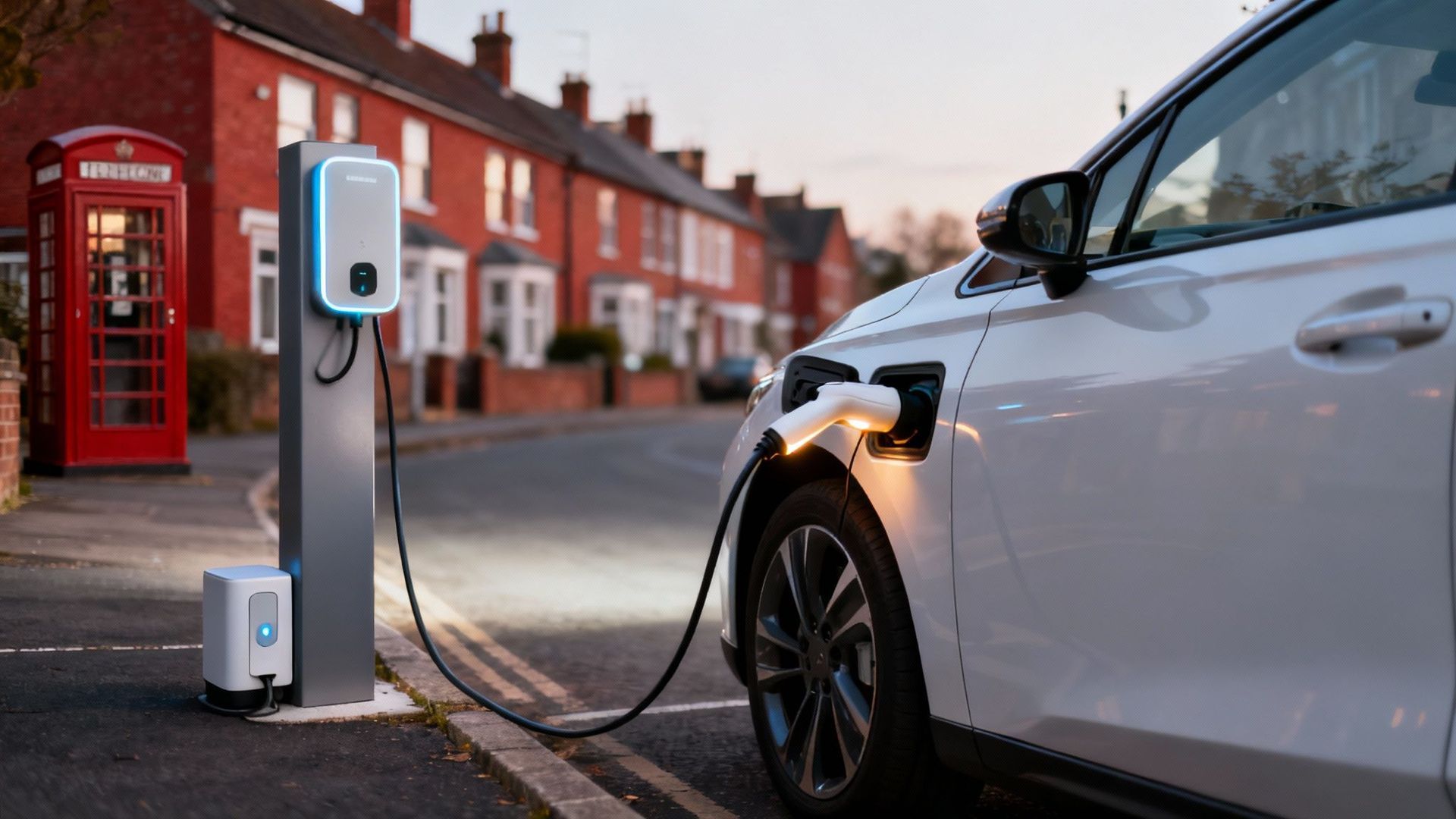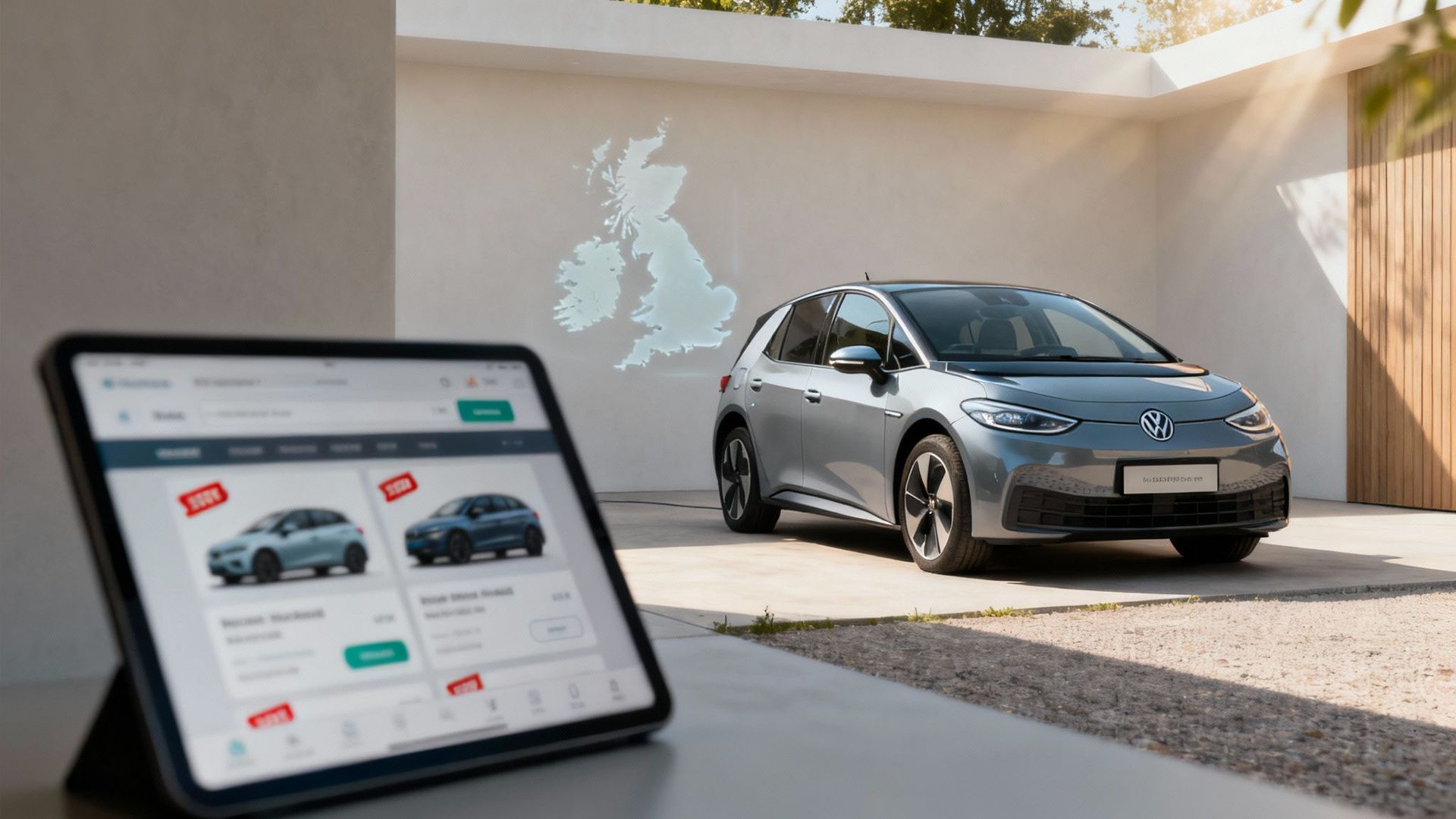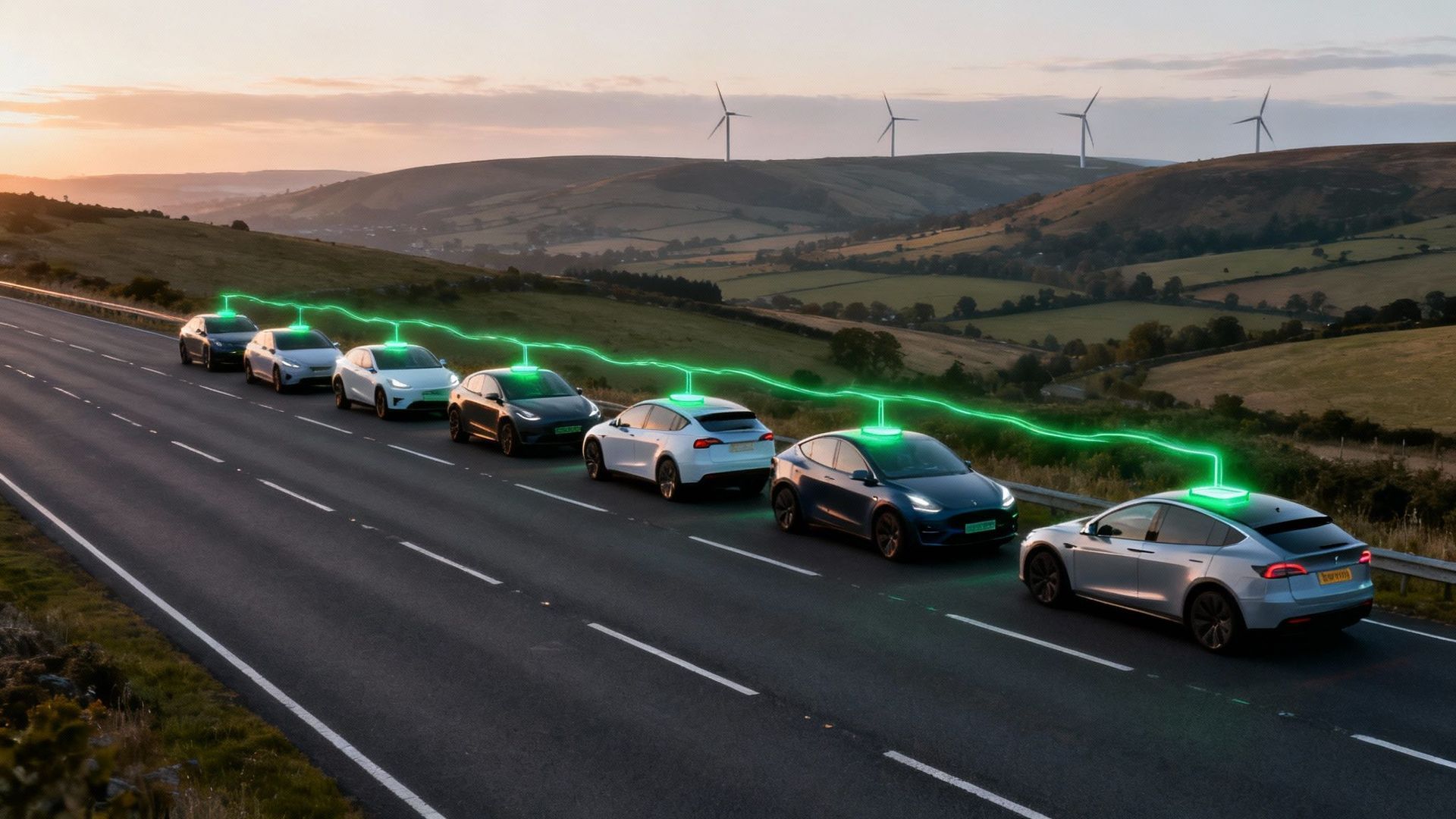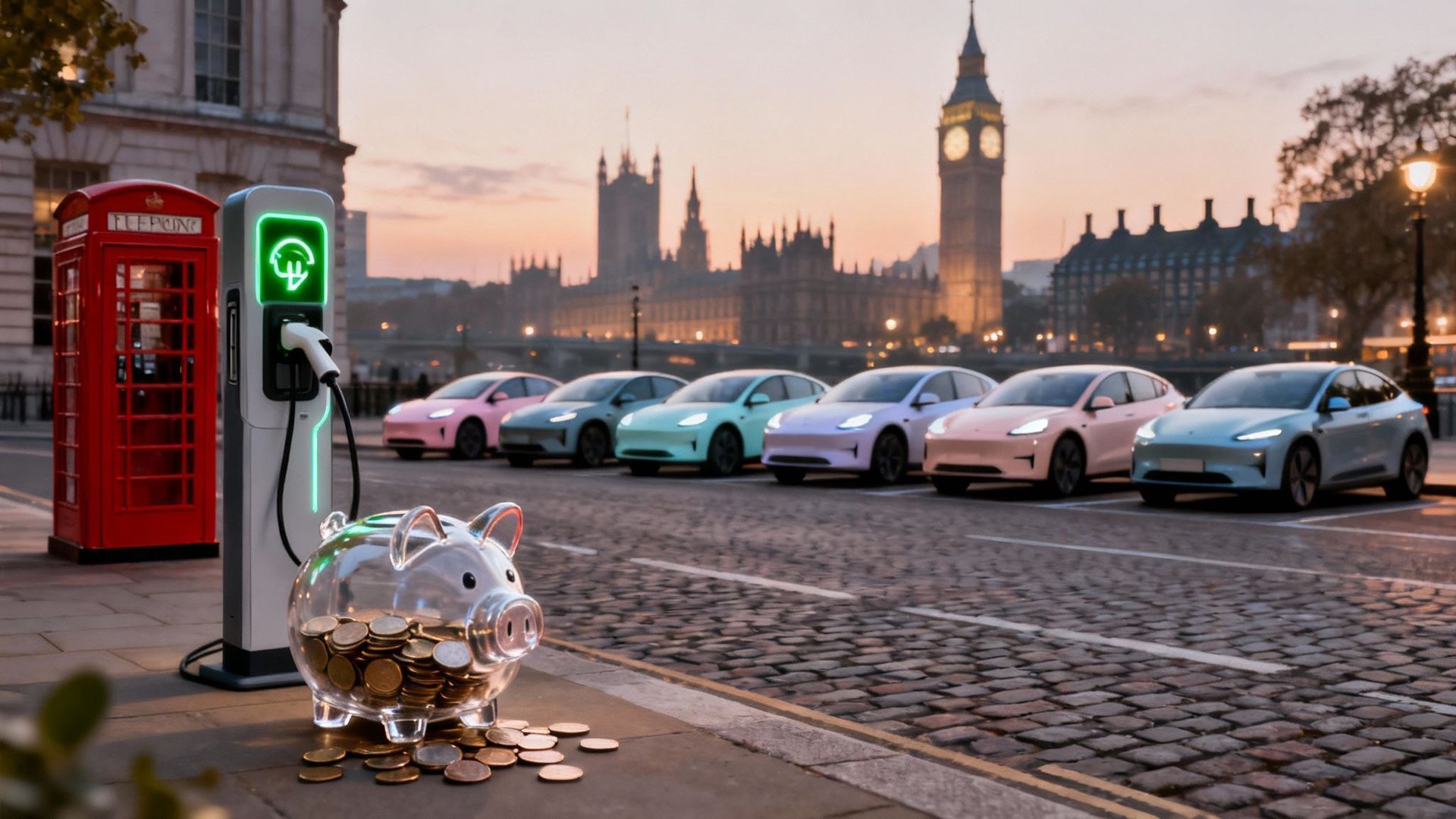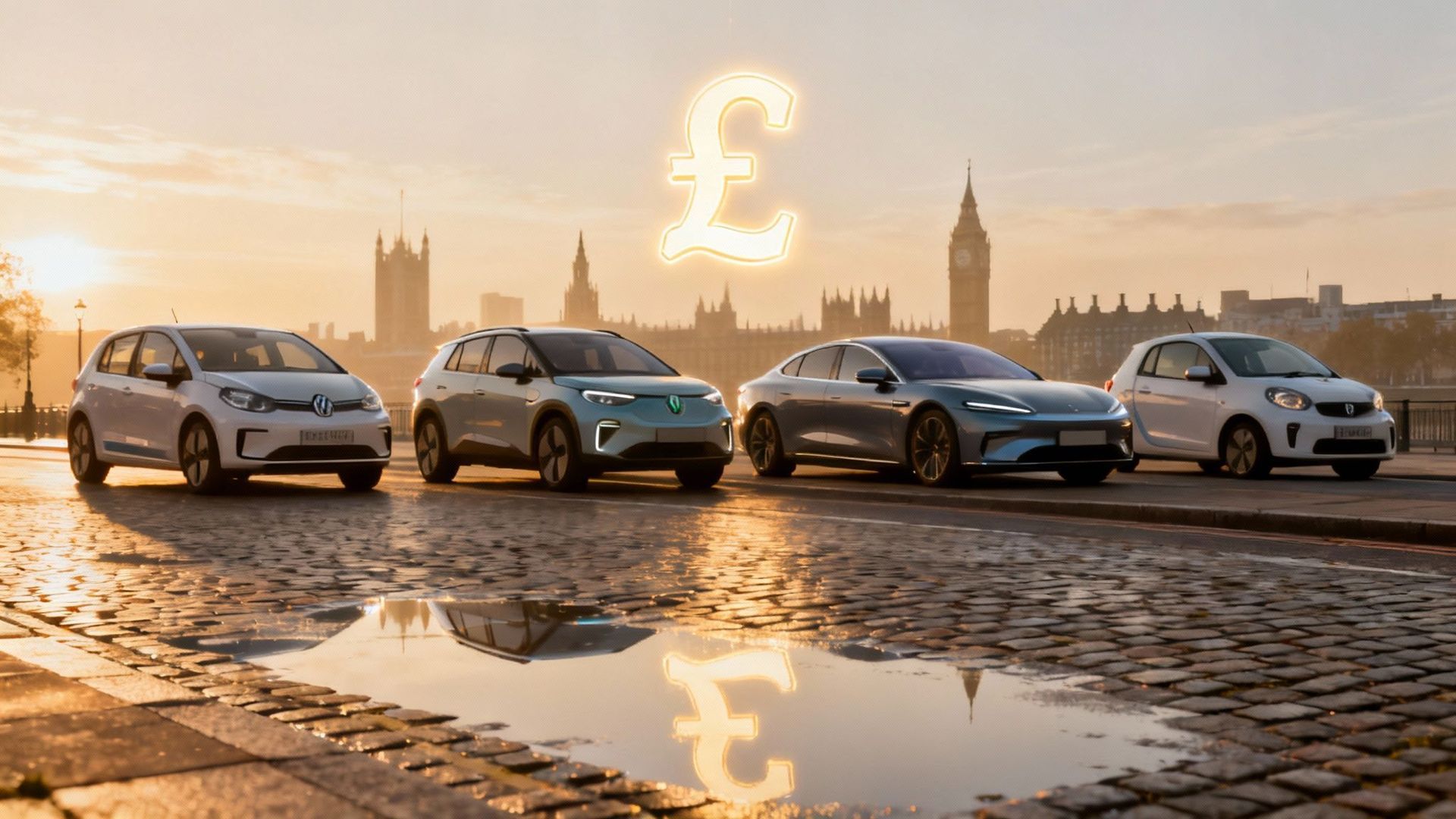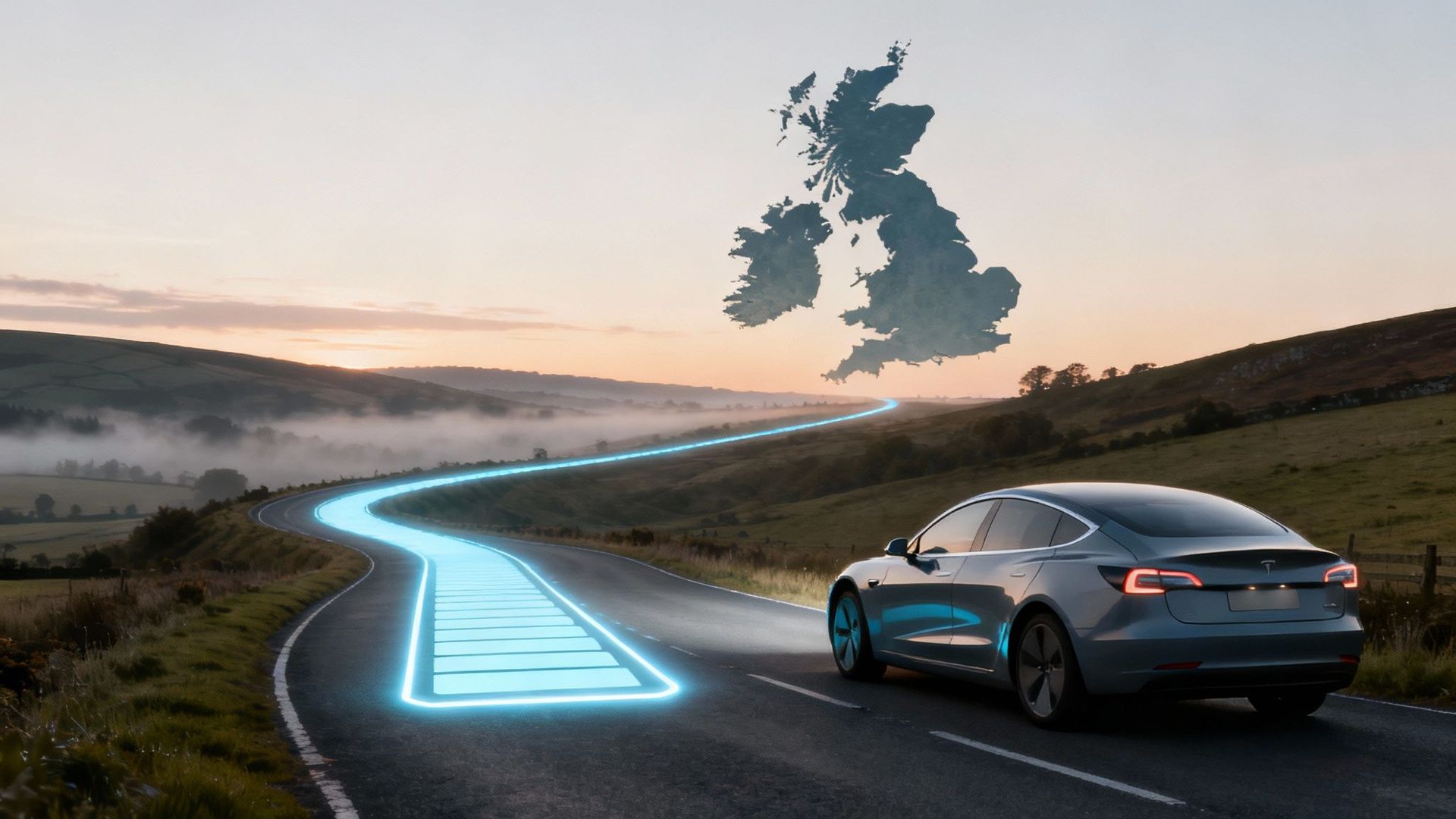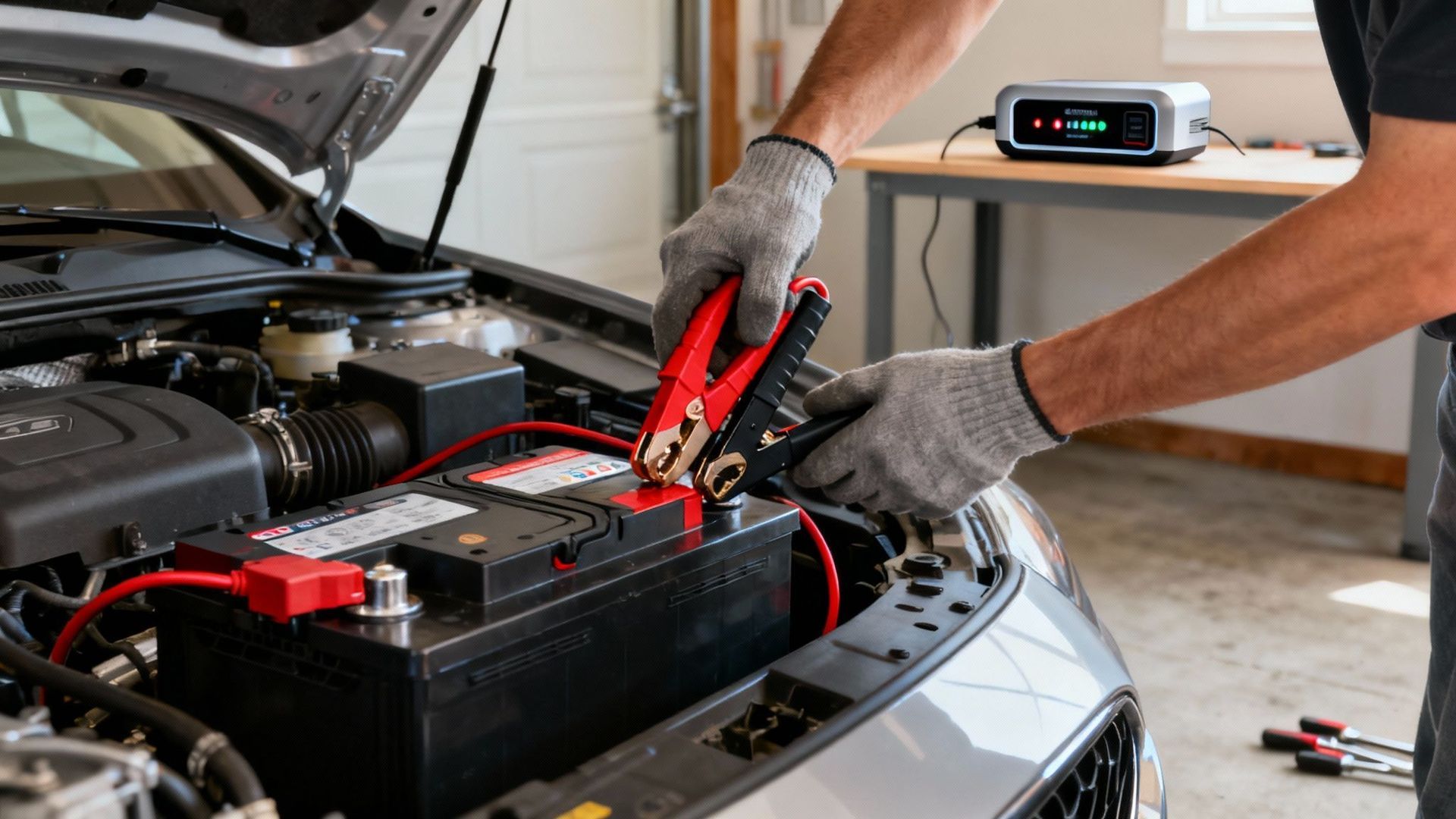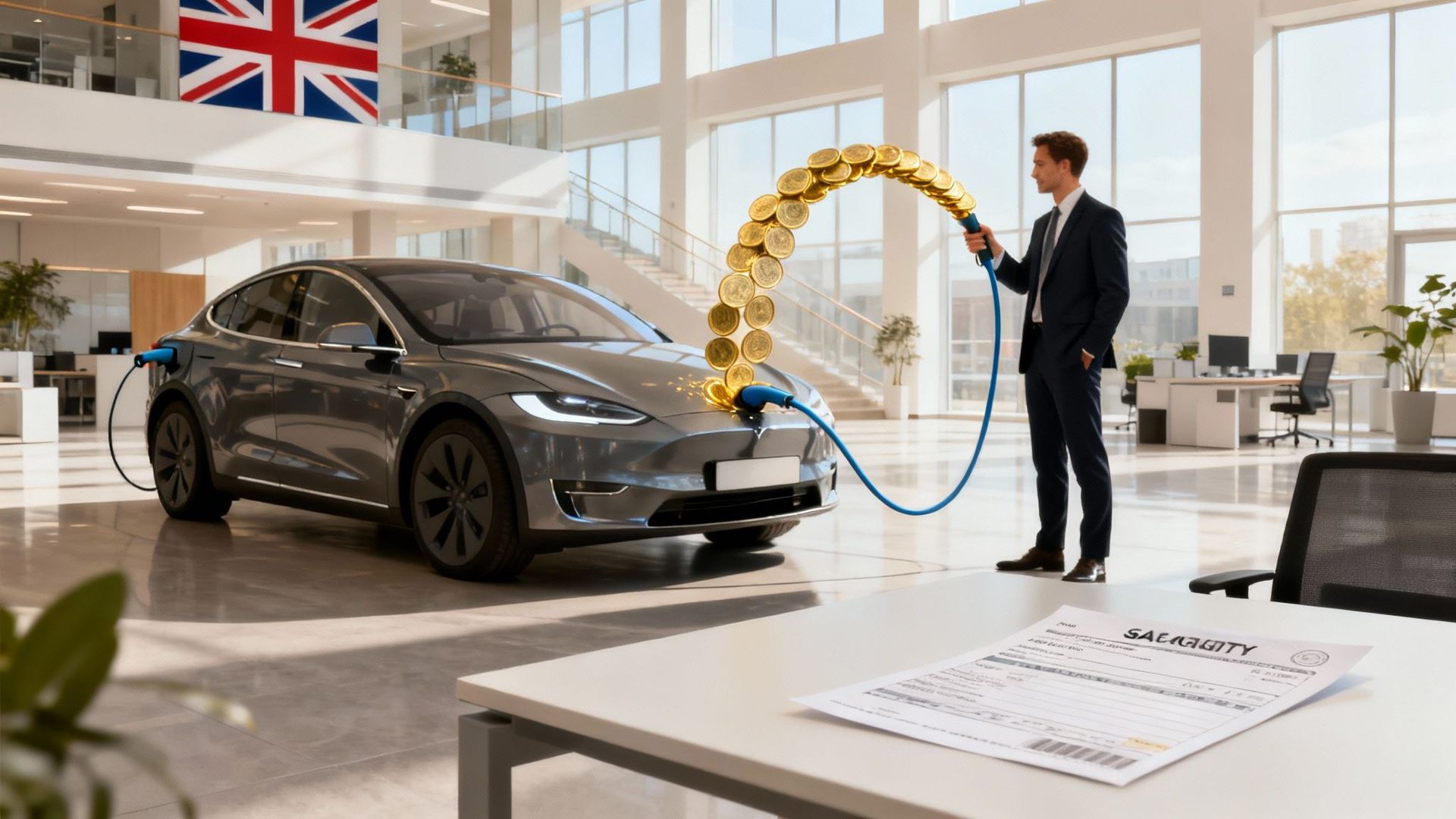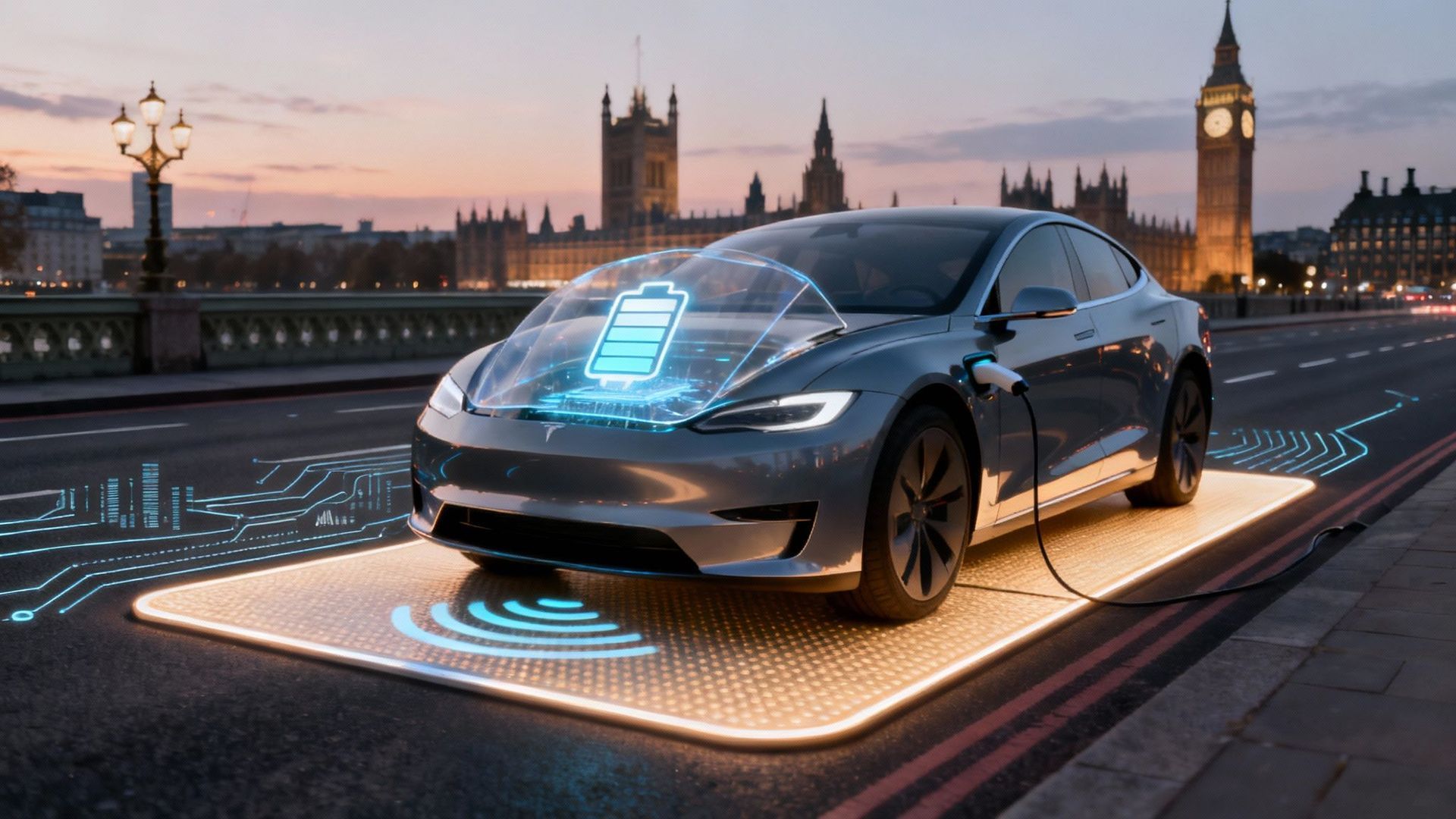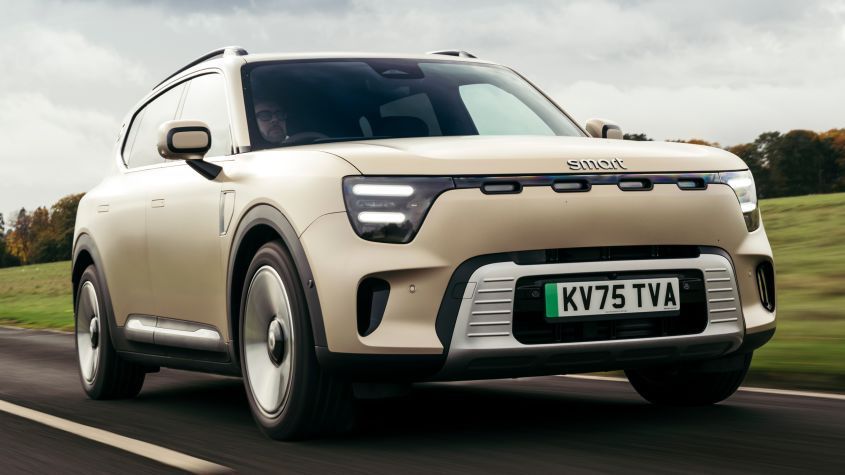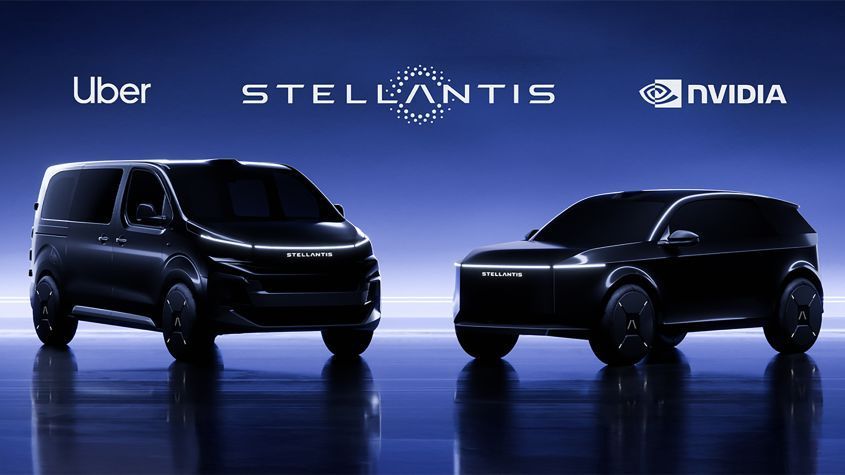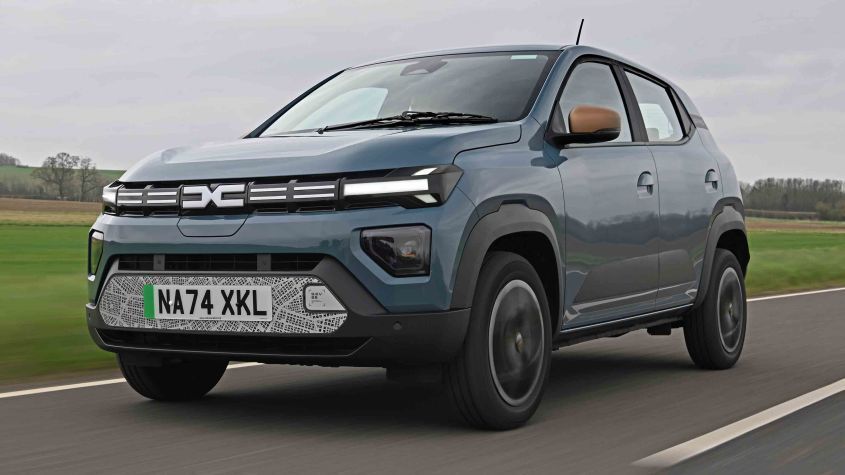Range Extender for Electric Vehicle: The Cure for a Flashing Light and a Squeaky Bum
So, what in blazes is an EV range extender? Put simply, it’s a tiny, onboard petrol generator that splutters into life to top up your car's battery when it's about to give up the ghost. It’s a clever, if slightly agricultural, bit of engineering designed to murder range anxiety once and for all, giving you a solid backup plan so you're never left stranded on the A1 with nothing but a packet of wine gums for company.
Banishing the Blinking Battery Light of Doom
Let's be honest. The biggest fear for most EV drivers isn't a surprise MOT bill or a rogue pheasant. It's that gut-wrenching feeling when the battery icon flashes red, and you're still 30 miles from the nearest charger that isn't broken or occupied by a milk float. That fear has a name: range anxiety. It's the spectre that haunts many a would-be electric car buyer.
This is precisely the problem a range extender for an electric vehicle was built to solve. Think of it as an emergency jerry can for your battery, but instead of faffing about with a funnel, it generates fresh electricity right when you need it most. It's your get-out-of-jail-free card when that ambitious jaunt to the seaside hits a snag.
How Does the Contraption Actually Work?
At its heart, a range extender is a compact internal combustion engine (ICE) bolted to a generator. The crucial point here is that this little engine never drives the wheels directly. Its sole purpose is to fire up automatically and create electricity.
That newly generated power is then sent straight to the battery or the electric motor, giving you those vital extra miles to reach your destination or a proper charging station.
It’s a smart compromise that offers the best of both worlds:
- Daily Pottering: You get the silent, zero-emission experience of pure electric power for your daily commute and trips to the tip.
- Proper Journeys: The anxiety of meticulously planning every single charging stop completely evaporates.
- Lighter, Cheaper Cars: Manufacturers can install smaller, less expensive battery packs, knowing the range extender is there as a backup.
The core idea is simple: provide the confidence of a full fuel tank without sacrificing the pure electric drive experience for 99% of your journeys. It's a safety net for the electric tightrope walker.
This technology directly tackles one of the biggest hurdles to widespread EV adoption. Range anxiety is still a massive concern for many drivers in the UK, but vehicles with range extenders have done a lot to calm those fears. As a result, we've seen a significant uptick in sales for plug-in hybrids (PHEVs) and extended-range electric vehicles (EREVs) that feature these onboard generators. You can get nerdy with the data on the UK EV range extender market to see just how the trend is shaping up.
How Do These Contraptions Actually Work?
Right, let's get under the bonnet and see what makes these things tick. Forget the marketing fluff for a moment. The concept behind a range extender for an electric vehicle is brilliantly simple, even if the execution feels a bit like a Frankenstein's monster of engineering. It’s all about giving you peace of mind without ruining that smooth, silent EV feel for your daily drives.
At its heart, most range extenders are just small internal combustion engines (ICE) that double as on-board generators. Picture a tiny, grumpy lawnmower engine that only wakes up to pump juice back into your battery. Crucially, it never actually turns the wheels itself.
This specific setup is known as a 'series hybrid' . The petrol engine's one and only job is to spin a generator, creating electricity. That power then flows either to top up the battery or directly to the electric motor that's actually propelling you forward. The driving experience remains purely electric: instant torque, no gear changes, and blissful silence... until the generator kicks in, of course.
The Two Flavours of Hybrid
Understanding the difference between hybrid types is key to grasping why a range extender feels so different from, say, a Toyota Prius. It all comes down to how the petrol engine gets involved in the action.
- Series Hybrid (The Range Extender): As we've covered, the engine is just a power plant. It has no physical connection to the wheels, meaning the car is always driven by its electric motor. This maintains that authentic EV driving sensation.
- Parallel Hybrid: In this more common setup, both the petrol engine and the electric motor can drive the wheels, sometimes at the same time. This is a far more mechanically complex system where the car's brain is constantly juggling power sources.
If you fancy a deeper dive into the nitty-gritty of how these systems compare, you can learn more about how hybrid cars work in our simple guide. The United Kingdom has become a major European market for electric vehicle range extenders, driven by the popularity of hybrids that offer a practical solution to range anxiety. For more detail, you can discover more insights about the European market on Precedence Research.
The easiest way to think about it is this: a series hybrid is an electric car with its own petrol-powered emergency generator. A parallel hybrid is a petrol car that gets a helpful electric shove.
This fundamental difference is precisely why a car like the BMW i3 REx feels like a proper EV, just one with a safety net built in. The engine is a passenger, not a co-pilot, and only gets to work when the battery needs a helping hand.
The Good, The Bad, and The Slightly Embarrassing
So, let's get down to brass tacks. No technology is perfect, and the range extender is a brilliant, messy compromise. It’s the automotive equivalent of having your cake and eating it too, only to find out the cake is a bit stale. Here’s the unvarnished truth about what you’re really signing up for.
The 'Good' is blindingly obvious. A range extender absolutely murders range anxiety. It takes that nagging fear of being stranded on the M6 with a dead battery and shoves it firmly in the boot. You get the freedom for spontaneous long journeys without needing a degree in logistics to plan your life around the wildly inconsistent public charging network.
This infographic shows the simple process of how an on-board engine generates power to keep you moving.
As you can see, the petrol engine is completely disconnected from the wheels, acting purely as a generator to top up the battery.
The Inconvenient Truths
Now for the 'Bad'. Strapping a petrol engine to an EV adds weight and complexity. You’re lugging around two separate power systems, which isn’t exactly a recipe for peak efficiency. This extra kit takes up space, adds kilos, and means you have another engine to service. Remember oil changes? Well, they're back.
Then there’s the 'Slightly Embarrassing' bit. It’s that moment your silent, futuristic EV—the one you've been smugly telling everyone is the future of transport—suddenly fires up a noisy little petrol engine. It’s a bit like putting ketchup on a Michelin-starred meal. The refined, serene driving experience is momentarily shattered by the chugging sound of what is, essentially, a high-tech generator.
The core trade-off is this: you gain absolute freedom from charging station queues, but you sacrifice the purity of the all-electric dream. It’s a pragmatic solution, but not an elegant one.
This brings us to a rather awkward point for the eco-warriors among us. While you're running on the extender, you’re producing emissions. Yes, it’s far less than a conventional car because the engine runs at its most efficient speed, but it’s not zero. It can feel a bit like cheating on your green principles.
Here’s a quick breakdown of the compromises:
- Weight Penalty: The extra engine and fuel tank can reduce your pure electric range slightly.
- Maintenance Hassle: You’re back to dealing with fossil-fuel engine upkeep, albeit on a smaller scale.
- Efficiency Loss: Converting petrol to electricity to motion is less efficient than just using stored electricity directly.
- The Racket: That sudden mechanical clatter can really kill the futuristic vibe.
Ultimately, the range extender is a fantastic bridging technology. It makes EV ownership genuinely practical for people who can't yet rely on the current charging infrastructure. It's just a solution that comes with a few inconvenient truths and the occasional, slightly embarrassing, soundtrack.
Real-World Motors with Range Extenders
Right, enough with the theory. Let's talk about the actual cars that put this technology on the road. A range extender for an electric vehicle isn't some futuristic fantasy; these vehicles have been driving among us for years. They served as a fantastic bridge for drivers who were intrigued by electric power but terrified by the thought of running out of juice.
Some were brilliant, others… not so much.
The Poster Child: BMW i3 REx
When you think of range extenders, one car immediately springs to mind: the BMW i3 REx . The standard all-electric i3 was a brilliant, forward-thinking city car, but its early battery gave it a range that could feel a bit restrictive. The REx model completely changed the equation.
Tucked away under the boot floor was a tiny 647cc two-cylinder engine nicked from one of BMW's scooters. This little generator never drove the wheels directly. Instead, its sole job was to kick in and keep the battery charged, effectively doubling the car's real-world range from about 80 miles to a much more usable 160-180 miles .
Suddenly, the i3 went from being a strictly urban machine to a car you could confidently take on a longer journey without constant panic. It was an elegant, if occasionally noisy, solution to the range anxiety problem. BMW has a history of clever hybrid engineering; you can discover if the BMW i8 is still a future classic in our deep-dive review.
A British Favourite: The Vauxhall Ampera
Another major player, especially here in the UK, was the Vauxhall Ampera and its twin, the Chevrolet Volt. This was a different beast altogether—a purpose-built series hybrid. It delivered a solid 40-50 miles of pure electric driving before its 1.4-litre petrol engine fired up to act as a generator.
The Ampera was a huge hit with critics, even winning European Car of the Year in 2012. It proved that a practical, family-sized car could do the daily commute entirely on electric power, without ever leaving its driver stranded on a long trip.
Iconic Range Extender Vehicles Compared
These early pioneers demonstrated just how effective a range extender could be. Here’s a quick look at how some of the most well-known models stacked up against each other.
| Vehicle Model | Battery-Only Range (Approx.) | Total Range with Extender (Approx.) | Extender Type |
|---|---|---|---|
| BMW i3 REx | 70-90 miles | 160-180 miles | 647cc 2-cylinder petrol |
| Vauxhall Ampera | 40-50 miles | 300+ miles | 1.4L 4-cylinder petrol |
| Chevrolet Volt | 40-50 miles | 300+ miles | 1.4L 4-cylinder petrol |
| Fisker Karma | 30-50 miles | 230 miles | 2.0L 4-cylinder turbo petrol |
As you can see, the approach was all about providing a reassuring safety net, turning a limited-range EV into a long-distance cruiser.
So, Where Did They All Go?
This all begs the question: if range extenders were so clever, why did manufacturers like BMW eventually drop them? The answer is simple: battery technology got really good, really fast.
These early models weren't about being perfect EVs. They were about proving a point: electric driving could be made practical for everyone, even when public charging was a rarity. They were the ultimate gateway drug to going fully electric.
As batteries became cheaper, lighter, and packed with more energy, the need for a secondary onboard engine faded. It became easier and more efficient to just install a bigger battery.
Still, their legacy is undeniable. They gave a whole generation of drivers the confidence to make the switch, and their spirit lives on in modern plug-in hybrids.
Is the Range Extender a Dying Breed?
So, what's the verdict on the range extender? Is it a brilliant stop-gap solution for the electric age, or just a relic destined for the same scrapheap as cassette players and dial-up modems? The jury is still out, but the evidence is certainly piling up against our petrol-powered safety net.
Let's be honest, the game has changed dramatically. Battery technology is advancing at a blistering pace. The first EVs were lucky to promise 100 miles on a good day with a tailwind. Now, manufacturers are casually advertising 300 miles or more from a single charge. When your car can cover that kind of distance, the crippling range anxiety that made extenders so appealing starts to feel a bit... pointless.
On top of that, the public charging network is finally getting its act together. It's still a bit of a postcode lottery in some areas, but the sheer number of chargers is growing every day. The argument for lugging around a whole separate petrol engine "just in case" is getting weaker all the time.
The Case for Extinction
At its core, the argument against the range extender is about purity and progress. The dream of a fully electric future is a powerful one. Adding a combustion engine—no matter how small or efficient—feels like taking a step backwards. It adds weight, complexity, and extra maintenance to what is supposed to be a simpler, more elegant machine.
Car manufacturers seem to agree. BMW eventually binned the REx option for the i3, confident that the bigger battery offered in later models was more than enough. Most new EVs are designed from the ground up without even a thought for a fossil-fuelled backup. Why? Because bigger, better batteries are seen as the real solution, not a messy compromise. To get a better sense of where things are headed, it's worth exploring the different visions for what electric cars in the future will look like.
The brutal truth is that lugging a petrol generator around in your state-of-the-art EV is like keeping a carrier pigeon for emergencies when you own a smartphone. It works, but it slightly misses the point of the new technology.
A Glimmer of Hope?
Don't write the obituary just yet, though. While the petrol-powered version may be on its way out, the fundamental concept of an onboard power source isn't dead. It's just evolving.
In fact, some emerging technologies could give the range extender a whole new lease of life, ditching the petrol pump for good:
- Hydrogen Fuel Cells: Imagine a system that generates electricity on the move, with water as its only emission. This is the holy grail: near-instant refuelling and zero nasty fumes from the tailpipe.
- Advanced Rotary Engines: Mazda is already using a super-compact Wankel rotary engine in its MX-30 R-EV. These engines are incredibly small, light, and smooth, making them almost perfect for generator duties.
- Microturbines: Think of a tiny jet engine. These could offer an incredibly efficient way to generate electricity and can often run on a variety of fuels.
So, while the little two-cylinder petrol engine might be a dying breed, the idea of extending range without a gigantic, heavy battery is very much alive. The future might just involve a far cleverer solution that finally kills range anxiety for good.
Quick Answers to Common Questions
Got a question? We've got you covered. We've gone through the what, why, and how of range extenders, but a few key questions always pop up. Here are the answers to the most frequently asked questions about electric vehicle range extenders, served up without the jargon.
| Question | Answer |
|---|---|
| Does the range extender directly drive the wheels? | Nope, never. The petrol engine in a range-extender EV acts purely as a generator. Its sole purpose is to produce electricity to recharge the battery or power the motor, not to turn the wheels. You always get a 100% electric driving feel. |
| Is a car with a range extender just a hybrid? | Technically yes, it's a 'series hybrid'. But it's worlds apart from a typical parallel hybrid like a Toyota Prius. In a range extender, the engine only generates power, while a parallel hybrid's engine can drive the wheels directly. |
| Do I still need to charge it from the mains? | Absolutely. You should treat it like a pure EV for daily driving. The petrol generator is your backup plan for long trips, not your primary fuel source. Relying on it full-time defeats the purpose and will be far more expensive. |
| Are new range extender models still being made? | Not as many as there used to be. As battery tech has improved and ranges have increased, the need for a petrol backup has faded. However, some car makers, like Mazda with its MX-30 R-EV, are still finding clever uses for the technology. |
Hopefully, that clears things up! Think of a range extender as an electric car first, with a handy little power station tucked away just in case. It’s a smart bit of engineering that helped bridge the gap to today’s long-range EVs.
At VoltsMonster , we cut through the noise to give you honest, entertaining, and insightful reviews and news from the world of electric vehicles. If you're tired of the same old boring car content, check out our latest articles and videos.

